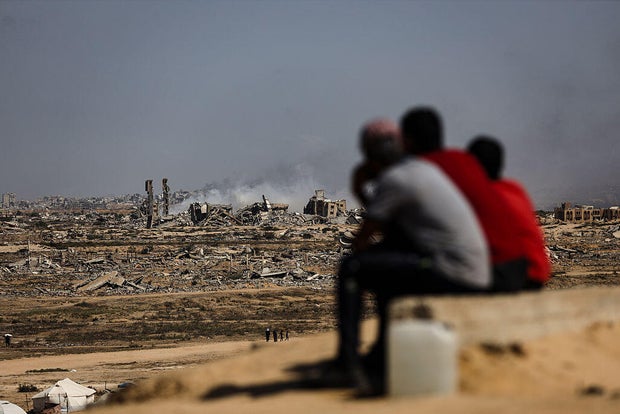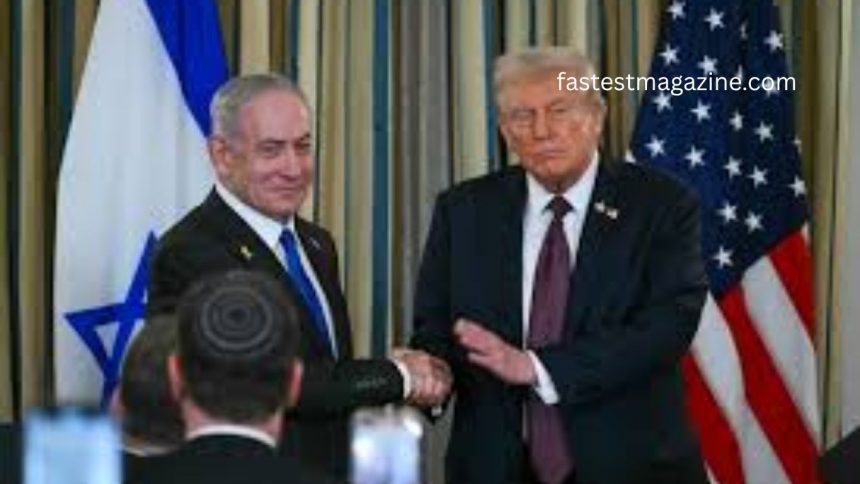Israeli Prime Minister Benjamin Netanyahu has expressed optimism that all hostages held in Gaza could soon return home. His announcement follows Hamas’ partial acceptance of former U.S. President Donald Trump’s recently proposed peace plan — a development that may signal a turning point in one of the world’s most enduring conflicts.
Read More: https://fastestmagazine.com/outrage-erupts-as-us-border-patrols/
Progress Toward a Breakthrough
Speaking late Saturday, Netanyahu confirmed that Israel had dispatched a delegation to Egypt to finalize the deal’s technical details. “Our goal is to contain these negotiations within days,” he said, highlighting his determination to reach a swift resolution. However, he also made clear that Israel does not plan a full withdrawal from Gaza — a long-standing demand from Hamas.
According to Hamas’ Friday statement, the group agreed to major components of Trump’s peace proposal, including the exchange of hostages for Palestinian prisoners. Yet, it insisted that other clauses remain open for negotiation. The U.S. government, viewing the response as “positive,” noted that discussions over weapon disarmament and other logistical issues could begin as soon as next week.
Trump Pushes for Immediate Ceasefire
Soon after Hamas’ statement, President Trump posted on Truth Social, declaring that he believes the militant group is “ready for a lasting peace.” He urged Israel to halt its bombardment of Gaza to ensure the safe and rapid release of hostages.
“Israel must immediately stop the bombing of Gaza so that we can get the hostages out safely and quickly,” Trump wrote, emphasizing that detailed discussions were already underway.
In response, Netanyahu’s office announced that Israel was preparing to implement the first phase of the Trump plan, aimed at the hostages’ immediate release. “We will continue to work closely with President Trump and his team to end the war under principles consistent with Israel’s security and Trump’s vision,” the statement read.

Israel’s Military Prepares for Implementation
The Israel Defense Forces (IDF) confirmed that senior officials met overnight to assess readiness for the plan’s first phase. IDF Chief of Staff Lt. Gen. Eyal Zamir reportedly ordered preparations to proceed “without delay.”
An Israeli political source told CBS News that while military activity in Gaza will temporarily pause to facilitate the hostages’ release, this does not constitute a formal ceasefire. “This is not a withdrawal,” the source clarified. “We are adjusting tactics to protect our soldiers while monitoring Hamas’ movements closely.”
Negotiations are expected to resume Sunday in Cairo, with U.S. special envoy Steve Witkoff and Trump’s son-in-law Jared Kushner joining the talks. Both are seen as key intermediaries between Washington, Jerusalem, and regional partners.
Regional and International Support Grows
In a video message, Trump described the deal as “unprecedented in many ways,” thanking Qatar, Egypt, and other Arab nations for mediating the talks. “This is a big day,” he said. “We’re finalizing the details that could end a tragedy spanning 3,000 years.”
On Saturday, Trump announced that Israel had agreed to an “initial withdrawal line,” shared with Hamas for review. Once confirmed, the ceasefire would take immediate effect, paving the way for a large-scale hostage-prisoner exchange and the start of phased Israeli withdrawal from Gaza.
The same day, the Palestinian Islamic Jihad (PIJ) — the second-largest militant faction in Gaza — also endorsed Hamas’ response to the Trump plan after initially rejecting it. This rare alignment among Palestinian factions is being viewed as a possible signal of unity ahead of broader peace efforts.
Hamas’ Conditional Acceptance and Terms
Hamas publicly declared its willingness to release all surviving hostages and the remains of the deceased under the exchange formula in Trump’s plan. The proposal requires Hamas to free all hostages taken during the October 7, 2023, attacks within 72 hours. In return, Israel would release 250 Palestinians serving life sentences and 1,700 additional prisoners detained since the start of the conflict.
The agreement also calls for a halt to hostilities once both sides formally accept the deal and for the Israeli military to withdraw to an agreed-upon boundary.
Moreover, Hamas signaled readiness to relinquish control of Gaza to a new Palestinian technocratic administration supported by Arab and Islamic nations — another key provision of Trump’s roadmap. The idea is to establish a neutral governing body to oversee reconstruction and stability in the post-war territory.
A senior Egyptian official confirmed that mediators are working toward both the hostage exchange and the release of hundreds of Palestinian prisoners. He added that Cairo and other Arab capitals are planning a broader dialogue aimed at unifying Palestinian leadership and determining Gaza’s future governance.
However, Hamas’ statement left ambiguity on certain elements of the deal. The group emphasized that some aspects “remain tied to a comprehensive national stance grounded in international law,” suggesting further consultations will be required. It remains unclear whether Hamas has agreed to fully step aside from Gaza’s governance, as stipulated in Trump’s proposal.
Trump’s Vision for Lasting Peace
The 20-point plan, revealed by Trump and Netanyahu at the White House on September 29, outlines a multi-phase approach to end the conflict. The first phase focuses on humanitarian access, the release of hostages, and the gradual withdrawal of Israeli forces. The second phase envisions Gaza’s reconstruction under a temporary international peacekeeping framework supported by Arab states.
Netanyahu endorsed the plan at its unveiling, asserting that Israel would “finish the job” if Hamas refused to comply. “We’re giving everyone a chance to make peace,” he said. “But if Hamas rejects this plan, Israel will act decisively. It can be done the easy way or the hard way — but it will be done.”
President Trump reaffirmed his commitment to Israel’s security while insisting that peace must be sustainable and long-term. He noted that several countries were already reviewing the agreement, signaling growing international participation in the effort.
Human Cost of the Conflict
Since Hamas’ surprise attack on southern Israel on October 7, 2023, which left about 1,200 Israelis dead and 251 taken hostage, the war has devastated Gaza. Israel’s retaliatory campaign has resulted in more than 66,000 Palestinian deaths, according to the Hamas-run Gaza Health Ministry. The toll includes both civilians and militants, though the ministry provides no breakdown.
The prolonged violence has displaced millions, crippled infrastructure, and drawn global condemnation, intensifying calls for a ceasefire. For many families, the proposed Trump plan — however controversial — offers the first tangible glimmer of hope for peace and stability.
A Potential Turning Point
If successful, the deal could mark one of the most significant diplomatic breakthroughs in decades for the Middle East. The cooperation of Hamas, Israel, the United States, and regional Arab mediators underscores a rare alignment of interests.
Still, analysts caution that previous ceasefire efforts have collapsed under mistrust and shifting political pressures. The success of this plan will depend on each side’s willingness to honor commitments and resist the temptation to return to the battlefield.
As negotiations resume in Cairo, the world watches closely. For the families of the remaining hostages — and for millions affected on both sides — the coming days may finally reveal whether this fragile moment of hope will become a lasting peace or another missed opportunity in a conflict that has already spanned generations.
Frequently Asked Questions:
What is the main focus of the recent peace discussions between Israel and Hamas?
The current peace discussions center on implementing parts of former U.S. President Donald Trump’s proposed peace plan. The top priority is securing the release of all hostages held in Gaza while negotiating a potential ceasefire and phased Israeli withdrawal.
What did Prime Minister Benjamin Netanyahu announce regarding the hostages?
Prime Minister Netanyahu expressed hope that all hostages in Gaza could be released “in the coming days.” He confirmed that Israeli negotiators are in Egypt to finalize technical details of the agreement.
How did Hamas respond to Trump’s peace plan?
Hamas said it accepts several key parts of Trump’s peace proposal, including the exchange of hostages for Palestinian prisoners. However, the group stated that some terms still require negotiation within a broader Palestinian framework.
What role is the United States playing in the negotiations?
The U.S. is acting as a key mediator in the talks. Special envoy Steve Witkoff and Jared Kushner, Trump’s senior advisor and son-in-law, are participating in Cairo discussions alongside Egyptian and Qatari officials.
Will Israel completely withdraw from Gaza under this deal?
No, Israel has ruled out a full withdrawal. The plan calls for an initial, limited pullback to a designated line to facilitate hostage exchanges and establish temporary peace conditions.
What does the Trump peace plan propose?
Trump’s 20-point peace plan calls for the immediate release of all hostages, a phased Israeli withdrawal, the establishment of a technocratic Palestinian administration in Gaza, and international efforts for reconstruction supported by Arab nations.
How soon could the ceasefire take effect?
According to Trump’s recent statement on Truth Social, the ceasefire could take effect immediately after Hamas confirms its acceptance of the initial withdrawal line proposed by Israel.
Conclusion
The renewed peace efforts between Israel and Hamas — centered on former President Trump’s plan and led by Prime Minister Netanyahu — mark a rare moment of optimism in a decades-long conflict. With both sides showing partial agreement, the possibility of releasing all hostages and easing tensions in Gaza feels closer than ever. While many challenges remain, including disagreements over withdrawal terms and future governance of Gaza, the involvement of the United States, Egypt, and other regional mediators adds momentum to the process. If these talks succeed, they could not only bring relief to countless families but also open a historic chapter of reconciliation and stability in the Middle East.













